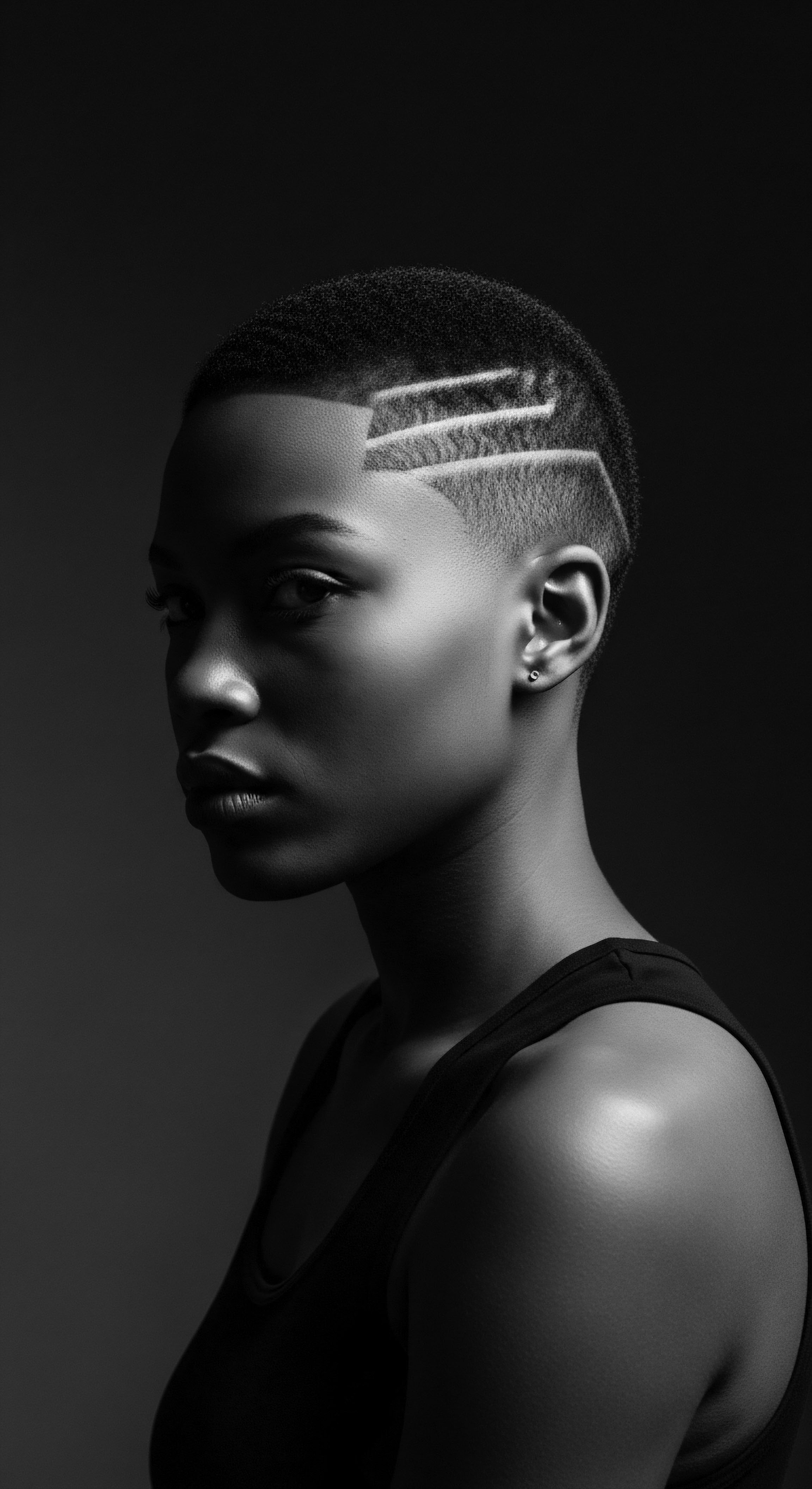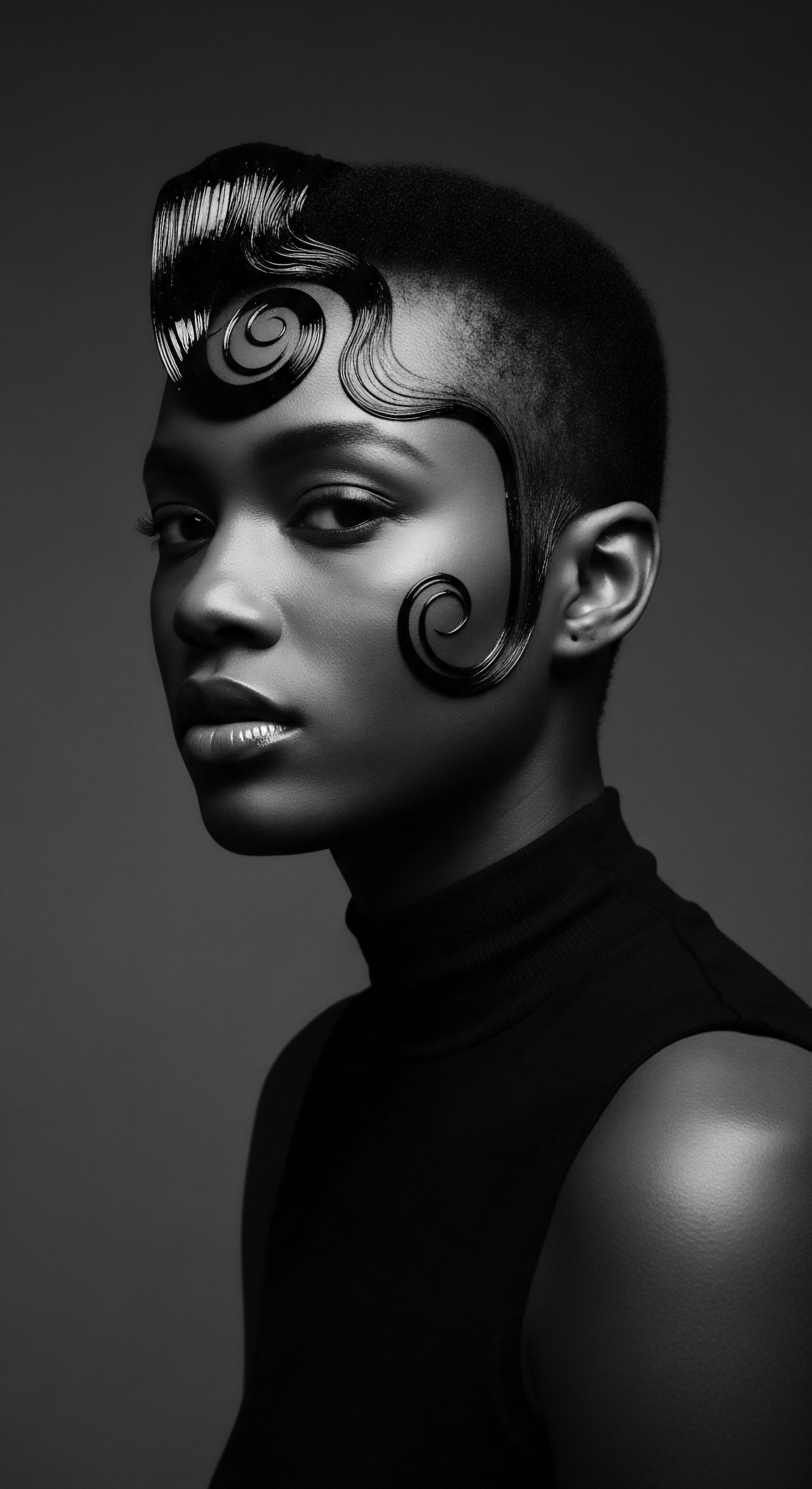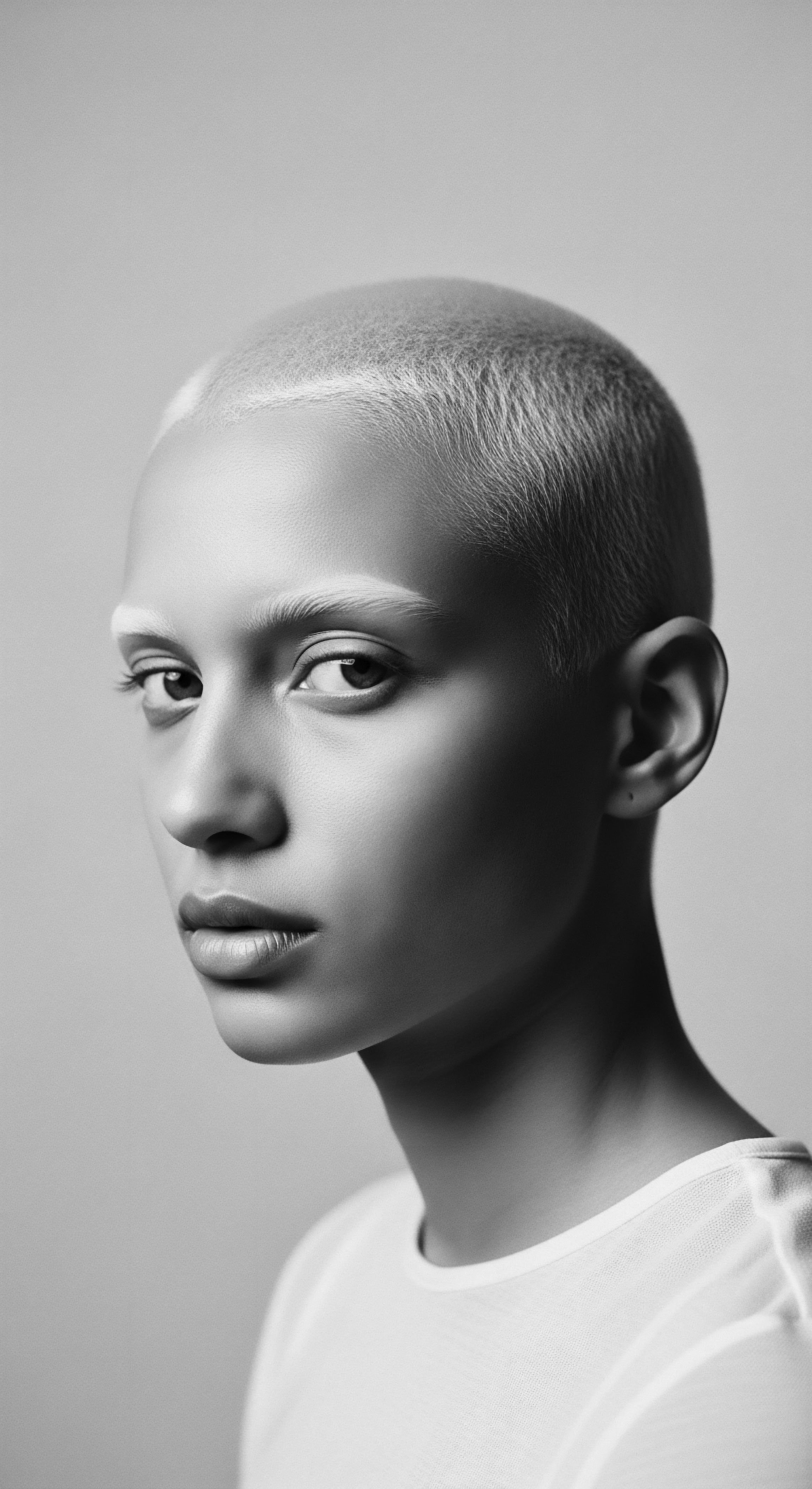
Roots
In the vibrant expanse of textured hair heritage, where each coil and curl tells a story of ancestry, resilience, and identity, the very notion of hair care transcends mere routine. It becomes a deeply rooted practice, an echo of wisdom passed down through generations. For those with hair that dances with its own unique rhythm, the challenge of static electricity is a familiar one, a whisper of disharmony in a symphony of strands. Yet, within the ancient embrace of nature, a simple, unassuming material holds a key to alleviating this disruption ❉ wood.
Its properties, often overlooked in the modern clamor for synthetic solutions, speak to an understanding of balance and connection that our ancestors knew intimately. This exploration delves into how the innate qualities of wood offer a gentle counterpoint to static, tracing this knowledge from elemental biology to the revered practices of our forebears.

What is the Elemental Origin of Static on Hair?
To grasp wood’s power against static, one must first understand static itself. Static electricity, in its simplest form, is an imbalance of electric charges on the surface of a material. When two unlike materials rub together, electrons—tiny, negatively charged particles—can transfer from one surface to another. This act of friction causes one material to gain electrons, becoming negatively charged, while the other loses them, becoming positively charged.
On hair, particularly textured hair with its inherent bends and turns, friction is a constant companion. The rubbing of strands against each other, or against synthetic fabrics and plastic combs, can easily disrupt the delicate equilibrium of electrons, leaving individual hairs charged with the same polarity. The consequence ❉ strands repelling one another, creating that familiar halo of flyaways and an unmanageable frizz (Geeshair, 2024).
Textured hair, with its diverse curl patterns and often drier nature, presents a unique canvas for this phenomenon. The increased surface area and the natural friction between coils mean that textured strands are perhaps more prone to acquiring and holding an electrical charge. When the air itself is dry, as it often is in cooler climates or artificially heated environments, there is less moisture to act as a conductor, less opportunity for these errant charges to dissipate into the atmosphere. The charges linger, leading to persistent static (WECOLOUR, 2025).
The quiet wisdom of wood, understood by our ancestors, offers a gentle remedy to static, inviting balance to textured strands.

How does Wood Reduce Static from a Heritage Perspective?
The solution, or at least a significant part of it, often lies within the very materials we choose to engage with our hair. Wood, an ancient and abundant gift from the earth, stands apart from many modern materials. Its fundamental properties render it a natural ally in the battle against static. Consider first its electrical conductivity ❉ wood is an insulator.
Unlike plastics, which readily accumulate and hold static charges, wood does not easily allow the transfer of electrons. When a wooden comb glides through hair, the friction generated is far less likely to cause a disruptive electrical exchange, thereby minimizing the buildup of static electricity (VEGA, 2023).
Beyond its insulating nature, wood possesses a subtle, yet significant, hygroscopic quality. This means wood can absorb and release moisture from the surrounding air. In dry environments, a wooden comb might hold a minute amount of atmospheric moisture, which then helps to conduct and dissipate any minor static charges that might form on the hair.
It acts as a grounding presence, gently mediating the electrical dance between strands and comb. This inherent ability to work in harmony with environmental humidity speaks to a deep, elemental wisdom that transcends mere technology.
Another aspect is the natural smoothness of well-crafted wood. Unlike some plastic combs that may have microscopic rough edges from manufacturing, a polished wooden comb presents a remarkably smooth surface. This reduces the mechanical friction on the hair cuticle as the comb passes through, further lessening the likelihood of electron transfer and hair damage (Geeshair, 2024).
Additionally, some woods contain natural oils that can be subtly transferred to the hair during combing, offering a light conditioning effect that enhances smoothness and reduces dryness, both factors that contribute to static. This multifaceted interaction, where the material itself participates in the hair’s wellbeing, connects directly to ancestral practices that honored natural materials for their holistic benefits.

Ritual
The journey of textured hair care, especially within Black and mixed-race communities, is rarely a solitary scientific endeavor. It is a ritual, a profound connection to lineage, community, and self. The very tools used carry the echoes of hands that styled generations, hands that understood the nuances of diverse curl patterns long before modern science articulated them. Wood, as a material for hair tools, holds a particularly sacred place within this heritage, its properties intuitively understood and honored for centuries.

What Traditional Wooden Tools Have Graced Textured Hair?
Across the African continent and throughout the diaspora, wooden combs and picks have been more than functional objects; they have been artistic expressions, cultural markers, and repositories of ancestral wisdom. Archaeological discoveries in ancient Kemet (Egypt) and Kush (Sudan) reveal combs dating back 5,500 to 7,000 years, often buried with their owners, signifying the deep reverence for hair and its styling tools. These early combs, many crafted from wood, bone, or ivory, bore intricate carvings ❉ symbols of tribal identity, social standing, fertility, or even spiritual protection (CurlyTreats, 2025; Africa Rebirth, 2022).
Consider the Dua’afe of Ghana, a traditional wooden comb often associated with femininity and beauty, sometimes given as a declaration of love or a marriage gift (Synergi Salon, 2024). These combs, with their wide, carefully spaced teeth, were perfectly suited for navigating the intricate landscape of coiled and curled hair, detangling with a gentleness that prevented breakage and tearing. The very act of combing with these tools became a moment of connection, a tender ritual often shared between mothers and daughters, or within communal gatherings. The wood itself, perhaps from specific trees like rubber wood or mahogany in West Africa, or olive wood in North Africa, was chosen not only for its durability but also for its inherent qualities that nurtured the hair (Geeshair, 2024).
Wooden combs, far from simple tools, are ancestral vessels, whispering stories of resilience and care through their very grain.
The practice of using wooden tools extended beyond combs. In some Indigenous cultures of North America, for instance, heated pieces of wood or bone were employed to shape hair, a testament to resourcefulness and deep respect for natural surroundings (Sister Sky, 2023). While these particular methods might not directly address static, they underscore the historical human understanding of wood as a material that works with hair, rather than against it, respecting its natural integrity. The connection to ancestral practices is not merely nostalgic; it validates a long-held understanding of materials that benefit textured hair in a holistic sense.
Historically, the widespread use of wood in hair care is a powerful testament to its efficacy. Plastic combs, with their tendency to generate static, are a relatively recent invention. Before their advent, human hands and natural materials were the primary tools.
The smooth, static-reducing properties of wood were not abstract scientific theories, but lived experiences, felt in the gentle glide of a comb through coils, observing the hair remain settled and soft. This practical knowledge, honed over millennia, forms a foundational layer of textured hair heritage.
| Material Wood (e.g. Ebony, Neem, Mahogany) |
| Traditional Context/Heritage Link Ancient African and Asian civilizations; widespread in diaspora; often symbolic; gentle detangling. |
| Static Reduction Mechanism Natural insulator, low friction, potential for subtle moisture absorption, some woods have natural oils. |
| Material Bone/Horn |
| Traditional Context/Heritage Link Ancient Egypt, Indigenous cultures; often carved for ceremonial use. |
| Static Reduction Mechanism Similar to wood, low electrical conductivity, smooth surface when polished. |
| Material Ivory |
| Traditional Context/Heritage Link Ancient royalty, nobility; status symbol. |
| Static Reduction Mechanism Smooth surface, but ethical concerns preclude modern use. |
| Material The selection of natural materials for hair tools, often steeped in cultural significance, inherently prioritized qualities that minimized hair disturbance. |

How do Wood’s Physical Properties Interact with Textured Hair to Minimize Static?
The scientific explanation for wood’s anti-static capabilities rests upon its physical and electrical characteristics. Unlike materials such as plastic, which are poor conductors and thus allow static charge to build up on their surfaces and on the hair, wood has some capacity to dissipate charge. This is primarily due to its non-conductive nature and, for many wood types, their subtle moisture content (Reddit, 2024). When wood makes contact with hair, it does not readily transfer electrons in a way that creates an imbalance, or if a minor charge does occur, the wood’s inherent properties allow it to discharge slowly and harmlessly (Nabhi Sutra, 2025).
Consider the process of combing. As a comb moves through hair, friction occurs. With a plastic comb, this friction can strip electrons from the hair, leaving the strands positively charged and repelling each other (Jolie, 2025). Wood, conversely, is less likely to engage in this electron transfer.
Its smooth, often finely polished surface glides through the hair, minimizing the frictional forces that lead to static buildup (Organic B, 2023). This gentle glide also reduces physical stress on the hair shaft, which helps preserve the cuticle layer, making the hair less prone to dryness and damage—conditions that exacerbate static (Agelock Skin Clinics, 2025).
Furthermore, the porosity of wood can play a subtle, beneficial role. Wood can interact with the natural oils of the scalp, helping to distribute them along the hair shaft. This even distribution of sebum provides a natural conditioning effect, adding moisture and smoothness to the hair.
Hydrated, well-conditioned hair is inherently less prone to static electricity because moisture acts as a conductor, allowing charges to dissipate more readily. The wooden comb, therefore, becomes a tool for both physical detangling and subtle, natural conditioning, working in concert with the hair’s own biology (Agelock Skin Clinics, 2025).

Relay
The wisdom embedded in the choice of wood for hair care extends beyond simple observation; it reflects a sophisticated, intuitive understanding of material science interwoven with spiritual and cultural reverence. This ancestral knowledge, often seen as holistic wellness, finds compelling validation in contemporary scientific principles. The continuity of this practice, from ancient African kingdoms to the modern diaspora, speaks volumes about its effectiveness and cultural significance. We are not merely examining an object; we are tracing a legacy of care, a conversation between epochs, revealing the deep reasons wood remains a touchstone for textured hair heritage.

What Specific Properties of Wood Contribute to Anti-Static Results?
The mechanism by which wood mitigates static on textured hair involves a confluence of physical and electrical attributes. At its core, wood is an electrical insulator, meaning it resists the flow of electric current. Unlike plastics, which are often dielectric materials that readily accumulate and hold electrostatic charges due to triboelectric effects, wood’s molecular structure does not easily facilitate this charge buildup. When a comb made of wood moves through hair, the friction causes a minimal transfer of electrons, significantly reducing the generation of static electricity compared to synthetic materials (Nabhi Sutra, 2025; Geeshair, 2024).
The moisture content within wood also plays a part. While wood is an insulator, it is also hygroscopic, meaning it absorbs and releases moisture from the ambient environment. This slight, inherent moisture within the wood itself acts as a conduit for any minor electrostatic charges that might develop during combing.
The charge can slowly dissipate through the wood and into the atmosphere, or even into the hand holding the comb, thereby neutralizing the static buildup on the hair (Reddit, 2024). This stands in contrast to dry plastic, where charges remain trapped, leading to hair strands repelling each other with noticeable force (Jolie, 2025).
Furthermore, the physical characteristics of well-finished wooden combs contribute substantially to static reduction. The teeth of a quality wooden comb are typically wide, smooth, and often rounded. This design minimizes mechanical friction and snagging on the hair cuticle.
Textured hair, with its naturally raised cuticle layers and varied curl patterns, is particularly susceptible to friction-induced damage. By reducing this friction, wooden combs help to keep the cuticle smooth and flattened, which in turn reduces the surface area available for charge buildup and minimizes the tangling that often leads to static (Agelock Skin Clinics, 2025; VEGA, 2023).
- Electrical Insulation ❉ Wood does not readily conduct electricity, preventing the accumulation of static charges that plastics often generate (Nabhi Sutra, 2025).
- Hygroscopic Tendency ❉ Natural moisture within wood can help dissipate minor electrostatic charges, grounding the hair.
- Smooth Surface Texture ❉ Polished wood reduces friction, minimizing cuticle damage and electron transfer (Agelock Skin Clinics, 2025).
- Natural Oil Distribution ❉ Some woods can subtly distribute hair’s natural oils, contributing to hair’s moisture balance and reducing dryness-induced static.

What Historical Evidence Reinforces Wood’s Role in Hair Static Management for Textured Hair?
The efficacy of wooden combs in reducing static is not a novel discovery; it is a principle long observed and utilized in ancestral hair care practices. While ancient texts may not use the term “static electricity,” the consistent preference for natural materials like wood over millennia, particularly in regions where diverse textured hair types are prevalent, speaks volumes. For example, the detailed artistry and widespread presence of wooden afro combs dating back thousands of years in Ancient Egypt and across West Africa (CurlyTreats, 2025; Africa Rebirth, 2022) points to their enduring utility. These combs were not merely ornamental; they were functional tools.
The very act of crafting a comb from wood involved an intimate knowledge of the material, suggesting an intuitive understanding of its beneficial properties for hair. The “Origins of the Afro Comb” project at the Fitzwilliam Museum, in collaboration with Cambridge University, showcases the rich history of these tools, noting their significance in practical hair care, cultural expression, and ritual (Fitzwilliam Museum, 2013).
One compelling example of this ancestral wisdom comes from historical practices in South Asia, where the Neem Wood Comb holds particular reverence. Beyond its noted antimicrobial properties, Neem wood is celebrated for its anti-static qualities. The tradition of using Neem combs for detangling and scalp health, passed down through generations, directly aligns with modern understanding of how wood interacts with hair to minimize static and frizz (Little Extra, 2023; Organic B, 2023). This enduring preference for Neem wood in a region with a diversity of hair textures underscores a heritage of practical knowledge that favored materials which promoted hair harmony over static disruption.
Consider also the cultural significance of hair care rituals in many communities. The deliberate, often slow, movements associated with combing textured hair with traditional wooden tools allowed for a gentler detangling process. This deliberate pace, facilitated by the wood’s smooth glide, minimized the rapid friction that generates static.
The very act became a meditative practice, far removed from the hurried, often damaging, passes of modern plastic brushes. This confluence of material science and mindful practice created an environment where static was naturally less pronounced, ensuring hair remained manageable, soft, and less prone to disruption.
| Ancestral Observation/Heritage Practice Hair remains smooth and manageable after combing. |
| Modern Scientific Explanation Wood's insulating properties and low friction minimize electron transfer, reducing static buildup. |
| Ancestral Observation/Heritage Practice Hair feels soft and nourished; less prone to dryness. |
| Modern Scientific Explanation Wood's slight hygroscopic nature and ability to distribute natural oils contribute to moisture balance. |
| Ancestral Observation/Heritage Practice Combs are gentle on hair and scalp, reducing breakage. |
| Modern Scientific Explanation Smooth, wide teeth of wooden combs reduce mechanical stress on delicate textured strands. |
| Ancestral Observation/Heritage Practice The enduring wisdom of ancestral hair care practices, centered on natural materials, aligns with contemporary scientific understanding of wood's inherent anti-static qualities. |

Reflection
To stand at the crossroads of ancestral wisdom and modern scientific understanding, particularly when contemplating the unassuming wooden comb, is to feel the profound heartbeat of Roothea’s ‘Soul of a Strand’ ethos. It is a recognition that the care of textured hair is not a fleeting trend or a superficial pursuit. Instead, it is a living, breathing archive of history, resilience, and beauty. The simple inquiry into how wood reduces static on textured hair unfurls into a sprawling narrative that reaches back through millennia, touching upon the hands that carved the first combs, the rituals that shaped communities, and the scientific truths hidden within the very fibers of the earth.
The journey from the elemental biology of wood to its role in preserving textured hair’s inherent grace speaks to an enduring heritage. It reminds us that often, the most effective solutions are those that align with nature’s rhythms, solutions discovered not through complex laboratories alone, but through generations of lived experience and an intimate relationship with the natural world. This legacy teaches us that hair, in its myriad forms, is a sacred part of our being, a tangible link to those who came before us. Caring for it with tools steeped in this heritage, like the wooden comb, becomes an act of honoring that continuum.
The whisper of static on a cold, dry day is more than a minor inconvenience; it is a call to reconnect with practices that prioritize harmony. It is a gentle reminder to choose materials that respect the delicate electrical balance of our hair, materials that reflect the reverence our ancestors held for every strand. As we continue to navigate the evolving landscape of hair care, the wooden comb stands as a quiet testament to enduring wisdom, a tangible piece of our collective heritage, continuing to guide us towards a future where textured hair remains unbound, luminous, and truly free.

References
- Agelock Skin Clinics. (2025, June 5). 10 Hidden Benefits of Using a Wooden Comb You Never Knew.
- Africa Rebirth. (2022, April 18). The African Tales of The Historical 7000 Year Old Afro Comb.
- CurlyTreats. (2025, February 8). Afro comb ❉ the cultural and political legacy behind this iconic hair tool.
- Geeshair. (2024, June 13). What Kind Of Anti Static Comb Would You Choose?
- Geeshair. (2024, April 13). Wooden comb curly hair is good?
- Jolie. (2025, February 18). How Can I Get Rid of Static Hair? Here’s 3 At-Home Solutions.
- Little Extra. (2023, October 18). Neem Wood Comb Versus Plastic Comb ❉ Which Is Better?
- Nabhi Sutra. (2025, April 22). KANSA COMB FOR SCALP AND HAIR HEALTH.
- Organic B. (2023, July 10). Unlocking Surprising Hair Benefits with Wooden Combs.
- Reddit. (2024, October 15). Can someone verify this? Is this actually a thing or is someone just making a fool out of gullible people.
- Sister Sky. (2023, November 10). How Native Americans Used Heat to Style Their Hair.
- Synergi Salon. (2024, February 7). Afro Combs ❉ A Timeless Emblem of Black Identity and Empowerment.
- VEGA. (2023, February 16). Why Wooden Combs Are Better – Benefits & Hair Care Tips!
- WECOLOUR. (2025, February 27). 10 tips to prevent static hair.
